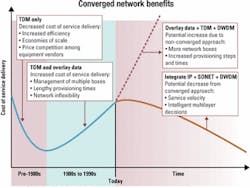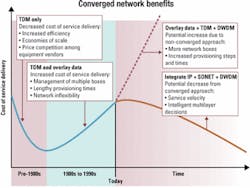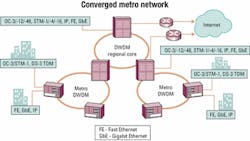What's preventing the convergence of voice and data?
A converged network serves as a platform for enhanced services by providing flexible and intelligent decision-making across multiple layers-so why aren't more carriers signing up?
SATHYA NARAYANASWAMY and RAJIVE DHAR, Atoga Systems
Converged architectures that support circuit-switched and advanced data services on the same network platform have always generated attention, both positive and negative, from different carriers. While these architectures promise immense benefits by lowering costs and increasing revenue through differentiated services and increased service velocity, carriers are not deploying these networks on a wide scale. This reluctance arises from economic reasoning, deep-rooted organizational issues, and shortcomings in previously touted solutions.
Incremental investments
For many years, carriers have developed their networks around the voice and circuit services predominantly demanded by customers, steadily investing billions of dollars in SONET and TDM technology. When data traffic boomed during the 1990s, its inherently bursty and connectionless nature resulted in poor bandwidth efficiency, because nailed-up circuits were directly used for transport. To solve this transport inefficiency, carriers added overlay data networks while continuing to use SONET as the underlying transport layer.
Today, the exponential growth in data traffic continues to place increasing demands on the underlying transport capacity. To address this issue, carriers have tried to deploy more SONET capacity but have run into fiber plant exhaust and physical limitations at higher bit rates. With the advent of DWDM, network planners are looking at this technology as an option to solve their transport capacity problems while still using most existing network equipment.
The rationale behind adding an overlay data network on top of SONET was driven in part by the unavailability of a converged platform for most of the 1990s. Since then, many equipment vendors have identified this deficiency and marketed solutions for it.Despite the availability of these solutions, network planners continue to add independent layers and expand each layer as needed on its own (see Figure 1). This pattern of incremental investment in each layer is a result of a primary focus on minimizing additional capital expenditure without calculating the total cost of ownership. The step-by-step capacity augmentation is resulting in carrier networks consisting of a smorgasbord of equipment and incompatible management platforms, thus preventing true convergence (see Figure 2).
Separate organizations
When overlay data networks were deployed, carriers created a separate data organization to manage them, because it required a different set of skills. The transport organization remained in charge of the SONET and DWDM layers.
Data organizations are increasing significantly in size and in importance to the carrier. That is occurring in step with growth in data traffic, requiring the data organization to plan and manage increasingly complex networks. Meanwhile, the transport organization has limited visibility into this traffic, rendering it unable to plan appropriately, while the data team can't offer enhanced services because of the inflexibility of the transport layers.
Separated decision-making and distinct budgets are preventing the two sides from collaborating on planning a converged network. Both organizations will need to change to accommodate convergence.
Equipment shortcomings
Even though the potential benefits of converged architectures are well understood, optimism among carriers has given way to skepticism. A number of vendors sprung up and touted solutions that were going to be the panacea for all networking evils. However, carriers found that what vendors called converged solutions were little more than SONET boxes with rudimentary packet interfaces or packet-based boxes with proprietary Layer 1/0 solutions.
The first class of products enhanced SONET by packaging data inside nailed-up circuits. To guarantee quality of service (QoS), fixed time slots were used to transport data, resulting in poor bandwidth efficiency and leaving the problem of inflexible transport unresolved. Moreover, these boxes were packet-aware but offered none of the rich functionality afforded by processing Layer 3 and above. As a result, these platforms could be deployed to continue offering TDM services and basic data transport but were not flexible enough to offer enhanced data services.
The second class of products, while offering complex packet functionality, offered nonstandard Layer 1/0 solutions. These Layer 1/0 solutions, although claiming to be SONET-like, did not offer the carrier-class protection and restoration carriers have come to trust. Moreover, the use of a proprietary solution made these products difficult to administer, requiring significant training for support personnel. Thus, these over-hyped solutions failed to clearly demonstrate the benefits of converged networks, increasing the dubiety among carriers.
Total cost points to convergence
These roadblocks in the way of converged networks are not insurmountable. The recent downturn in the telecommunications market is causing carriers' executive management to focus on how to reduce the cost of service delivery. These executives, with a more holistic view of the business than individual network planners, are finding clear proof that the existing layer-by-layer approach is ballooning the total cost of ownership. Although the incremental acquisition of equipment for each layer appears to save dollars when evaluated on a per-upgrade basis, over the long term, it increases capital expenditures as more and more equipment is required. Moreover, the incompatible management platforms deployed for these different boxes are driving up the costs of provisioning, increasing time-to-market, and hurting customer satisfaction.
The organizational issues preventing convergence are also coming to the fore. Executives are scrutinizing their reporting and control structures to uncover inefficiencies. After realizing that the nonalignment of goals between the data and transport organizations is acting as a deterrent to convergence, these management teams are modifying operating structures to promote cooperation.
The incentive to effect these changes is powerful. A converged platform can deliver strong operational efficiency, which translates into lower costs, quicker turnarounds, and a seamless migration to a network that can support high-margin enhanced services.
The onus for providing the final piece of the puzzle is on equipment vendors. For carriers, the Internet boom was a cataclysmic event. It caught carriers by surprise and forced these companies to scramble to upgrade their voice-oriented networks to support data, as well. Today, as carriers look to the future, various service offerings seem to have the potential to become the next "killer app." Earlier system solutions were adapted toward one or more of these nascent blockbusters, forcing carriers to make a choice. Given this scenario, carriers chose to wait rather than make the wrong choice. Now, as carriers plan deployments, convergence solutions must offer multiple benefits, allowing these operators the adaptability to futureproof their networks.
Required attributesService velocity is the central tenet of a converged network. As customer-demand patterns change from requiring static bandwidth pipes to supporting dynamic bandwidth on demand, carriers must respond quickly. That requires a platform that provides rapid provisioning. But rapid provisioning, if provided independently at each layer, adds little value. To provide true service velocity, a platform must be able to make intelligent decisions spanning multiple layers and provision in one step. Thus, a converged-network solution should combine the IP data layer with the transport layers, as shown in Figure 3.Among business customers, corporate objectives have spurred extensive information processing and operations on a global scale. Networking technology solutions like SANs and virtual private networks have risen to address these needs. This trend is shifting enterprise connectivity requirements from raw bandwidth to services tailored on an application-specific basis to ensure that applications are given a priority (class of service and QoS). A converged-network solution should support complex Layer 3/2 functionality combined with deep packet lookups for application-specific processing.
Flexibility is another key requirement. As service velocity and application-specific provisioning become critical, carriers are also finding that each customer has unique needs. A one-shoe-fits-all approach depresses revenue and margins, since pricing is driven by the lowest common denominator. With the ability to customize bandwidth and other performance specifications on a per-customer and per-application basis, carriers can differentiate their offerings appropriately, thus ensuring their pricing matches the customer's price sensitivity. A converged-network solution should support advanced policing and metering, combined with a rich suite of customizable traffic priorities and queues.
Scalability refers to a capacity upgrade on an existing platform. This approach works well when traffic growth is steady and can be spotted early. For converged metro networks, however, the more important characteristic is optical scaling. Traffic patterns between multiple nodes in the network can vary quickly; therefore, a converged-network solution must be able to rapidly adapt to these changing patterns. As the platform makes intelligent decisions spanning multiple layers, a flexible optical layer where capacity can be dynamically adjusted is a necessity. Thus, a converged-network solution should support flexibility in the optical DWDM layer by being able to tune the wavelengths dynamically, based on information gathered at the higher layers.
The success of technologies such as SONET is partly due to standardization efforts driven by carriers and vendors. Standards help ensure that carriers' requirements are met and enable these operators to diversify their equipment purchases among vendors. Another benefit is a large pool of trained support staff that can leverage their knowledge of a particular technology across multiple platforms supporting that standard. SONET is a classic example of this process in action. Numerous vendors now offer SONET solutions, thus ensuring a competitive marketplace. Moreover, technicians first trained on OC-3 (155-Mbit/sec) equipment found their knowledge easily transferable to OC-12 (622 Mbits/sec), OC-48 (2.5 Gbits/sec), and higher. A standards-based platform confers both strategic and economic benefits to carriers. A converged-network solution should support SONET to facilitate a smooth transition from the current network infrastructure.
Wider adoption of converged networks will be achieved by changing the mindset of network planners to focus on total cost of ownership rather than an incremental economic approach. Realigning incentives and reporting structures to integrate data and transport network planning will steer the organization toward a converged solution.
The benefits of converged networks are clear. These architectures will enable carriers to increase revenue through enhanced services that adapt to customer demands and boost margins by reducing the cost of service delivery.
Sathya Narayanaswamy is senior product marketing manager and Rajive Dhar is director of solutions marketing at Atoga Systems (Fremont, CA). They can be reached via the company's Website, www.atoga.com.



